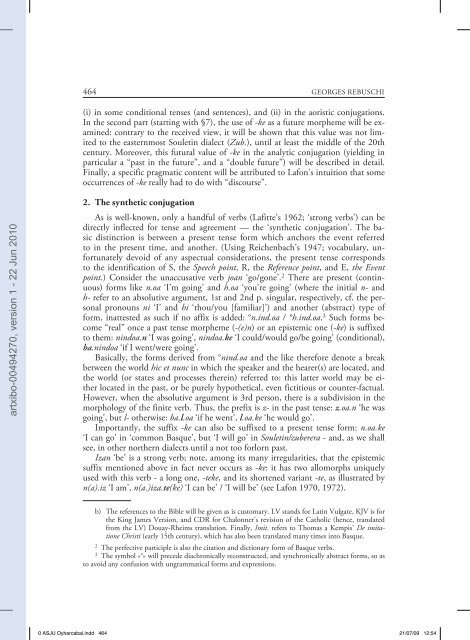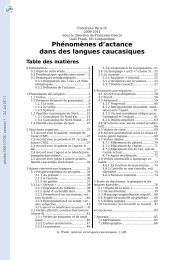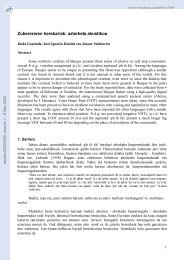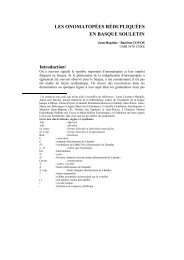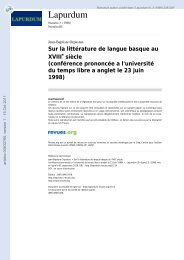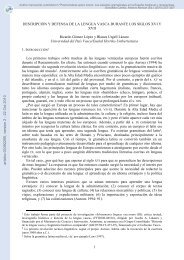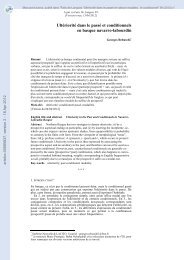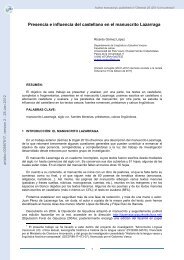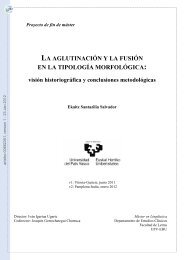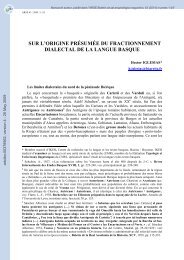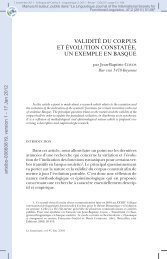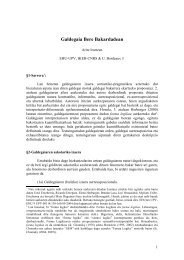On the polysemy of the suffike-ke in the history of Northern Basque
On the polysemy of the suffike-ke in the history of Northern Basque
On the polysemy of the suffike-ke in the history of Northern Basque
You also want an ePaper? Increase the reach of your titles
YUMPU automatically turns print PDFs into web optimized ePapers that Google loves.
artxibo-00494270, version 1 - 22 Jun 2010<br />
464 GEORGES REBUSCHI<br />
(i) <strong>in</strong> some conditional tenses (and sentences), and (ii) <strong>in</strong> <strong>the</strong> aoristic conjugations.<br />
In <strong>the</strong> second part (start<strong>in</strong>g with §7), <strong>the</strong> use <strong>of</strong> -<strong>ke</strong> as a future morpheme will be exam<strong>in</strong>ed:<br />
contrary to <strong>the</strong> received view, it will be shown that this value was not limited<br />
to <strong>the</strong> easternmost Soulet<strong>in</strong> dialect (Zub.), until at least <strong>the</strong> middle <strong>of</strong> <strong>the</strong> 20th<br />
century. Moreover, this futural value <strong>of</strong> -<strong>ke</strong> <strong>in</strong> <strong>the</strong> analytic conjugation (yield<strong>in</strong>g <strong>in</strong><br />
particular a “past <strong>in</strong> <strong>the</strong> future”, and a “double future”) will be described <strong>in</strong> detail.<br />
F<strong>in</strong>ally, a specific pragmatic content will be attributed to Lafon’s <strong>in</strong>tuition that some<br />
occurrences <strong>of</strong> -<strong>ke</strong> really had to do with “discourse”.<br />
2. The syn<strong>the</strong>tic conjugation<br />
As is well-known, only a handful <strong>of</strong> verbs (Lafitte’s 1962; ‘strong verbs’) can be<br />
directly <strong>in</strong>flected for tense and agreement — <strong>the</strong> ‘syn<strong>the</strong>tic conjugation’. The basic<br />
dist<strong>in</strong>ction is between a present tense form which anchors <strong>the</strong> event referred<br />
to <strong>in</strong> <strong>the</strong> present time, and ano<strong>the</strong>r. (Us<strong>in</strong>g Reichenbach’s 1947; vocabulary, unfortunately<br />
devoid <strong>of</strong> any aspectual considerations, <strong>the</strong> present tense corresponds<br />
to <strong>the</strong> identification <strong>of</strong> S, <strong>the</strong> Speech po<strong>in</strong>t, R, <strong>the</strong> Reference po<strong>in</strong>t, and E, <strong>the</strong> Event<br />
po<strong>in</strong>t.) Consider <strong>the</strong> unaccusative verb joan ‘go/gone’. 2 There are present (cont<strong>in</strong>uous)<br />
forms li<strong>ke</strong> n.oa ‘I’m go<strong>in</strong>g’ and h.oa ‘you’re go<strong>in</strong>g’ (where <strong>the</strong> <strong>in</strong>itial n- and<br />
h- refer to an absolutive argument, 1st and 2nd p. s<strong>in</strong>gular, respectively, cf. <strong>the</strong> personal<br />
pronouns ni ‘I’ and hi ‘thou/you [familiar]’) and ano<strong>the</strong>r (abstract) type <strong>of</strong><br />
form, <strong>in</strong>attested as such if no affix is added: °n.<strong>in</strong>d.oa / °h.<strong>in</strong>d.oa. 3 Such forms become<br />
“real” once a past tense morpheme (-(e)n) or an epistemic one (-<strong>ke</strong>) is suffixed<br />
to <strong>the</strong>m: n<strong>in</strong>doa.n ‘I was go<strong>in</strong>g’, n<strong>in</strong>doa.<strong>ke</strong> ‘I could/would go/be go<strong>in</strong>g’ (conditional),<br />
ba.n<strong>in</strong>doa ‘if I went/were go<strong>in</strong>g’.<br />
Basically, <strong>the</strong> forms derived from °n<strong>in</strong>d.oa and <strong>the</strong> li<strong>ke</strong> <strong>the</strong>refore denote a break<br />
between <strong>the</strong> world hic et nunc <strong>in</strong> which <strong>the</strong> spea<strong>ke</strong>r and <strong>the</strong> hearer(s) are located, and<br />
<strong>the</strong> world (or states and processes <strong>the</strong>re<strong>in</strong>) referred to: this latter world may be ei<strong>the</strong>r<br />
located <strong>in</strong> <strong>the</strong> past, or be purely hypo<strong>the</strong>tical, even fictitious or counter-factual.<br />
However, when <strong>the</strong> absolutive argument is 3rd person, <strong>the</strong>re is a subdivision <strong>in</strong> <strong>the</strong><br />
morphology <strong>of</strong> <strong>the</strong> f<strong>in</strong>ite verb. Thus, <strong>the</strong> prefix is z- <strong>in</strong> <strong>the</strong> past tense: z.oa.n ‘he was<br />
go<strong>in</strong>g’, but l- o<strong>the</strong>rwise: ba.l.oa ‘if he went’, l.oa.<strong>ke</strong> ‘he would go’.<br />
Importantly, <strong>the</strong> suffix -<strong>ke</strong> can also be suffixed to a present tense form: n.oa.<strong>ke</strong><br />
‘I can go’ <strong>in</strong> ‘common <strong>Basque</strong>’, but ‘I will go’ <strong>in</strong> Soulet<strong>in</strong>/zuberera - and, as we shall<br />
see, <strong>in</strong> o<strong>the</strong>r nor<strong>the</strong>rn dialects until a not too forlorn past.<br />
Izan ‘be’ is a strong verb; note, among its many irregularities, that <strong>the</strong> epistemic<br />
suffix mentioned above <strong>in</strong> fact never occurs as -<strong>ke</strong>: it has two allomorphs uniquely<br />
used with this verb - a long one, -te<strong>ke</strong>, and its shortened variant -te, as illustrated by<br />
n(a).iz ‘I am’, n(a.)iza.te(<strong>ke</strong>) ‘I can be’ / ‘I will be’ (see Lafon 1970, 1972).<br />
b) The references to <strong>the</strong> Bible will be given as is customary. LV stands for Lat<strong>in</strong> Vulgate, KJV is for<br />
<strong>the</strong> K<strong>in</strong>g James Version, and CDR for Chalonner’s revision <strong>of</strong> <strong>the</strong> Catholic (hence, translated<br />
from <strong>the</strong> LV) Douay-Rheims translation. F<strong>in</strong>ally, Imit. refers to Thomas a Kempis’ De imitatione<br />
Christi (early 15th century), which has also been translated many times <strong>in</strong>to <strong>Basque</strong>.<br />
2 The perfective participle is also <strong>the</strong> citation and dictionary form <strong>of</strong> <strong>Basque</strong> verbs.<br />
3 The symbol «°» will precede diachronically reconstructed, and synchronically abstract forms, so as<br />
to avoid any confusion with ungrammatical forms and expressions.<br />
0 ASJU Oyharcabal.<strong>in</strong>dd 464 21/07/09 12:54


